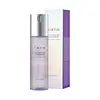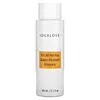What's inside
What's inside
 Key Ingredients
Key Ingredients

 Benefits
Benefits

 Concerns
Concerns

 Ingredients Side-by-side
Ingredients Side-by-side

Collagen Water
HumectantButylene Glycol
Humectant1,2-Hexanediol
Skin ConditioningNiacinamide
SmoothingPolyglycerin-3
HumectantWater
Skin ConditioningGlycereth-26
HumectantPanthenol
Skin ConditioningBetaine
HumectantPolyglyceryl-10 Laurate
Skin ConditioningEthylhexylglycerin
Skin ConditioningCaprylyl Glycol
EmollientSaccharide Isomerate
HumectantDipotassium Glycyrrhizate
HumectantAdenosine
Skin ConditioningParfum
MaskingTrehalose
HumectantPunica Granatum Extract
AstringentHydrolyzed Elastin
EmollientBeta-Glucan
Skin ConditioningGlycine
BufferingGarcinia Mangostana Peel Extract
Skin ConditioningClitoria Ternatea Flower Extract
Skin ConditioningSerine
MaskingGlutamic Acid
HumectantCyanocobalamin
Skin ConditioningCitric Acid
BufferingSodium Citrate
BufferingAspartic Acid
MaskingLeucine
Skin ConditioningAlanine
MaskingLysine
Skin ConditioningArginine
MaskingTyrosine
MaskingPhenylalanine
MaskingProline
Skin ConditioningThreonine
Valine
MaskingIsoleucine
Skin ConditioningHistidine
HumectantCysteine
AntioxidantMethionine
Skin ConditioningHydrogenated Lecithin
EmulsifyingPolyglyceryl-10 Stearate
Skin ConditioningSodium Hyaluronate
HumectantSoluble Proteoglycan
Skin ConditioningSodium Ascorbyl Phosphate
AntioxidantHydroxypropyltrimonium Hyaluronate
Hydrolyzed Hyaluronic Acid
HumectantPyridoxine
Skin ConditioningFolic Acid
Skin ConditioningSodium Acetylated Hyaluronate
HumectantBiotin
AntiseborrhoeicHyaluronic Acid
HumectantHydrolyzed Sodium Hyaluronate
Skin ConditioningTocopherol
AntioxidantSodium Hyaluronate Crosspolymer
HumectantPotassium Hyaluronate
Skin ConditioningThiamine Hcl
MaskingInositol
HumectantBeta-Carotene
Skin ConditioningRiboflavin
Cosmetic ColorantLinoleic Acid
CleansingCollagen Water, Butylene Glycol, 1,2-Hexanediol, Niacinamide, Polyglycerin-3, Water, Glycereth-26, Panthenol, Betaine, Polyglyceryl-10 Laurate, Ethylhexylglycerin, Caprylyl Glycol, Saccharide Isomerate, Dipotassium Glycyrrhizate, Adenosine, Parfum, Trehalose, Punica Granatum Extract, Hydrolyzed Elastin, Beta-Glucan, Glycine, Garcinia Mangostana Peel Extract, Clitoria Ternatea Flower Extract, Serine, Glutamic Acid, Cyanocobalamin, Citric Acid, Sodium Citrate, Aspartic Acid, Leucine, Alanine, Lysine, Arginine, Tyrosine, Phenylalanine, Proline, Threonine, Valine, Isoleucine, Histidine, Cysteine, Methionine, Hydrogenated Lecithin, Polyglyceryl-10 Stearate, Sodium Hyaluronate, Soluble Proteoglycan, Sodium Ascorbyl Phosphate, Hydroxypropyltrimonium Hyaluronate, Hydrolyzed Hyaluronic Acid, Pyridoxine, Folic Acid, Sodium Acetylated Hyaluronate, Biotin, Hyaluronic Acid, Hydrolyzed Sodium Hyaluronate, Tocopherol, Sodium Hyaluronate Crosspolymer, Potassium Hyaluronate, Thiamine Hcl, Inositol, Beta-Carotene, Riboflavin, Linoleic Acid
Galactomyces Ferment Filtrate
HumectantWater
Skin ConditioningButylene Glycol
HumectantPentylene Glycol
Skin Conditioning1,2-Hexanediol
Skin ConditioningBifida Ferment Lysate
Skin ConditioningLactobacillus Ferment
Skin ConditioningTripeptide-1
Skin ConditioningPalmitoyl Tripeptide-1
Skin ConditioningPalmitoyl Pentapeptide-4
Skin ConditioningHexapeptide-9
Skin ConditioningHexapeptide-11
Skin ConditioningCopper Tripeptide-1
Skin ConditioningSoluble Proteoglycan
Skin ConditioningPolygonum Cuspidatum Root Extract
AntioxidantCentella Asiatica Extract
CleansingScutellaria Baicalensis Root Extract
AstringentSodium Hyaluronate
HumectantGlycyrrhiza Glabra Root Extract
BleachingCamellia Sinensis Leaf Extract
AntimicrobialPanthenol
Skin ConditioningCeramide Ns
Skin ConditioningCeramide As
Skin ConditioningCeramide AP
Skin ConditioningCeramide NP
Skin ConditioningCeramide EOP
Skin ConditioningBetaine
HumectantPropanediol
SolventAllantoin
Skin ConditioningAdenosine
Skin ConditioningHydrogenated Lecithin
EmulsifyingRosmarinus Officinalis Leaf Extract
AntimicrobialChamomilla Recutita Flower Extract
MaskingPhytosphingosine
Skin ConditioningCholesterol
EmollientGlycerin
HumectantCetearyl Alcohol
EmollientStearic Acid
CleansingPolyglyceryl-10 Laurate
Skin ConditioningXanthan Gum
EmulsifyingCaprylyl Glycol
EmollientGalactomyces Ferment Filtrate, Water, Butylene Glycol, Pentylene Glycol, 1,2-Hexanediol, Bifida Ferment Lysate, Lactobacillus Ferment, Tripeptide-1, Palmitoyl Tripeptide-1, Palmitoyl Pentapeptide-4, Hexapeptide-9, Hexapeptide-11, Copper Tripeptide-1, Soluble Proteoglycan, Polygonum Cuspidatum Root Extract, Centella Asiatica Extract, Scutellaria Baicalensis Root Extract, Sodium Hyaluronate, Glycyrrhiza Glabra Root Extract, Camellia Sinensis Leaf Extract, Panthenol, Ceramide Ns, Ceramide As, Ceramide AP, Ceramide NP, Ceramide EOP, Betaine, Propanediol, Allantoin, Adenosine, Hydrogenated Lecithin, Rosmarinus Officinalis Leaf Extract, Chamomilla Recutita Flower Extract, Phytosphingosine, Cholesterol, Glycerin, Cetearyl Alcohol, Stearic Acid, Polyglyceryl-10 Laurate, Xanthan Gum, Caprylyl Glycol
 Reviews
Reviews

Ingredients Explained
These ingredients are found in both products.
Ingredients higher up in an ingredient list are typically present in a larger amount.
1,2-Hexanediol is a synthetic liquid and another multi-functional powerhouse.
It is a:
- Humectant, drawing moisture into the skin
- Emollient, helping to soften skin
- Solvent, dispersing and stabilizing formulas
- Preservative booster, enhancing the antimicrobial activity of other preservatives
Adenosine is in every living organism. It is one of four components in nucleic acids that helps store our DNA.
Adenosine has many benefits when used. These benefits include hydrating the skin, smoothing skin, and reducing wrinkles. Once applied, adenosine increases collagen production. It also helps with improving firmness and tissue repair.
Studies have found adenosine may also help with wound healing.
In skincare products, Adenosine is usually derived from yeast.
Learn more about AdenosineBetaine is a common humectant (a substance that promotes retention of moisture). It's known to be gentle on the skin and can help balance hydration.
This ingredient is best for improving hydration and soothing irritated skin. Studies also show it helps even out skin tone.
Fun fact: Betaine is naturally created in the skin and body. The kind found within cosmetic products can be either plant-derived or synthetic.
Another name for betaine is trimethylglycine.
Learn more about BetaineButylene Glycol (or BG) is used within cosmetic products for a few different reasons:
Overall, Butylene Glycol is a safe and well-rounded ingredient that works well with other ingredients.
Though this ingredient works well with most skin types, some people with sensitive skin may experience a reaction such as allergic rashes, closed comedones, or itchiness.
Learn more about Butylene GlycolCaprylyl Glycol is a humectant and emollient, meaning it attracts and preserves moisture.
It is a common ingredient in many products, especially those designed to hydrate skin. The primary benefits are retaining moisture, skin softening, and promoting a healthy skin barrier.
Though Caprylyl Glycol is an alcohol derived from fatty acids, it is not the kind that can dry out skin.
This ingredient is also used as a preservative to extend the life of products. It has slight antimicrobial properties.
Learn more about Caprylyl GlycolHydrogenated Lecithin is created from the hydrogenation of lecithin (a group of phospholipids). Hydrogenation is a chemical reaction between hydrogen and another element.
This ingredient is an emollient and emulsifier. As an emollient, it helps soften skin by trapping moisture within. As an emulsifier, it prevents oil and water ingredients from separating.
Panthenol is a common ingredient that helps hydrate and soothe the skin. It is found naturally in our skin and hair.
There are two forms of panthenol: D and L.
D-panthenol is also known as dexpanthenol. Most cosmetics use dexpanthenol or a mixture of D and L-panthenol.
Panthenol is famous due to its ability to go deeper into the skin's layers. Using this ingredient has numerous pros (and no cons):
Like hyaluronic acid, panthenol is a humectant. Humectants are able to bind and hold large amounts of water to keep skin hydrated.
This ingredient works well for wound healing. It works by increasing tissue in the wound and helps close open wounds.
Once oxidized, panthenol converts to pantothenic acid. Panthothenic acid is found in all living cells.
This ingredient is also referred to as pro-vitamin B5.
Learn more about PanthenolPolyglyceryl-10 Laurate is an ester of lauric acid and Polyglycerin-10.
Polyglyceryl-10 Laurate is a cleansing agent and emulsifier. It helps gather dirt, oil, and other pollutants to be rinsed away. As an emulsifier, it helps prevent ingredients from separating, such as oil and water.
Polyglyceryl-10 Laurate may not be fungal acne safe.
Learn more about Polyglyceryl-10 LaurateSodium Hyaluronate is hyaluronic acid's salt form. It is commonly derived from the sodium salt of hyaluronic acid.
Like hyaluronic acid, it is great at holding water and acts as a humectant. This makes it a great skin hydrating ingredient.
Sodium Hyaluronate is naturally occurring in our bodies and is mostly found in eye fluid and joints.
These are some other common types of Hyaluronic Acid:
Learn more about Sodium HyaluronateWe don't have a description for Soluble Proteoglycan yet.
Water. It's the most common cosmetic ingredient of all. You'll usually see it at the top of ingredient lists, meaning that it makes up the largest part of the product.
So why is it so popular? Water most often acts as a solvent - this means that it helps dissolve other ingredients into the formulation.
You'll also recognize water as that liquid we all need to stay alive. If you see this, drink a glass of water. Stay hydrated!
Learn more about Water